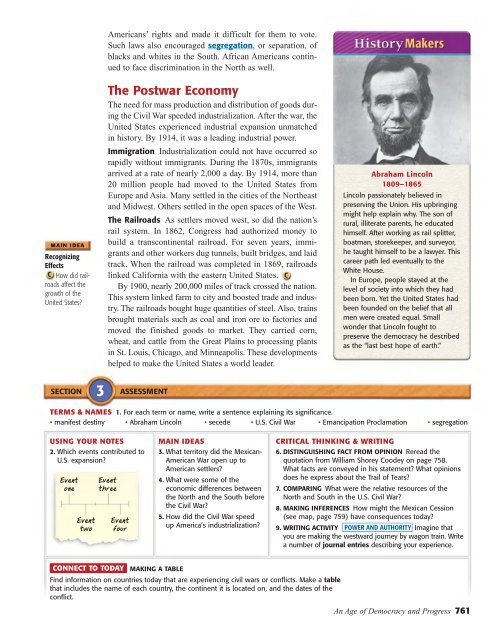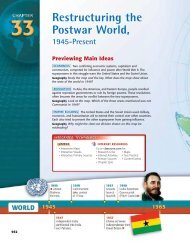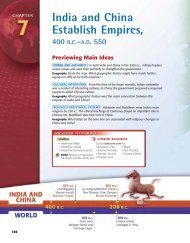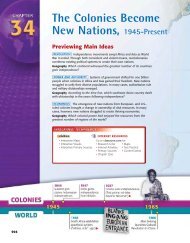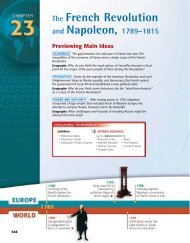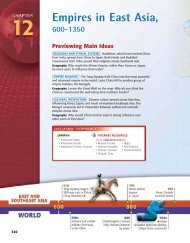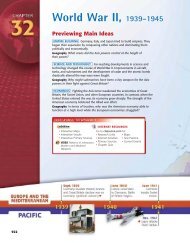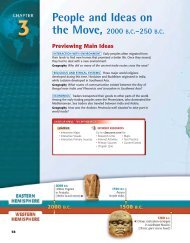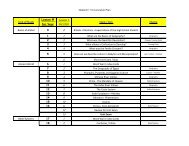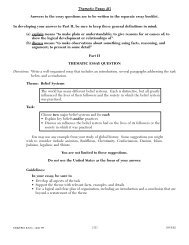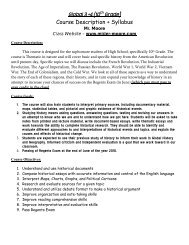The Industrial Revolution, 1700– 1900 Previewing Main Ideas
The Industrial Revolution, 1700– 1900 Previewing Main Ideas
The Industrial Revolution, 1700– 1900 Previewing Main Ideas
You also want an ePaper? Increase the reach of your titles
YUMPU automatically turns print PDFs into web optimized ePapers that Google loves.
Recognizing<br />
Effects<br />
How did railroads<br />
affect the<br />
growth of the<br />
United States?<br />
Americans’ rights and made it difficult for them to vote.<br />
Such laws also encouraged segregation, or separation, of<br />
blacks and whites in the South. African Americans continued<br />
to face discrimination in the North as well.<br />
<strong>The</strong> Postwar Economy<br />
<strong>The</strong> need for mass production and distribution of goods during<br />
the Civil War speeded industrialization. After the war, the<br />
United States experienced industrial expansion unmatched<br />
in history. By 1914, it was a leading industrial power.<br />
Immigration <strong>Industrial</strong>ization could not have occurred so<br />
rapidly without immigrants. During the 1870s, immigrants<br />
arrived at a rate of nearly 2,000 a day. By 1914, more than<br />
20 million people had moved to the United States from<br />
Europe and Asia. Many settled in the cities of the Northeast<br />
and Midwest. Others settled in the open spaces of the West.<br />
<strong>The</strong> Railroads As settlers moved west, so did the nation’s<br />
rail system. In 1862, Congress had authorized money to<br />
build a transcontinental railroad. For seven years, immigrants<br />
and other workers dug tunnels, built bridges, and laid<br />
track. When the railroad was completed in 1869, railroads<br />
linked California with the eastern United States.<br />
By <strong>1900</strong>, nearly 200,000 miles of track crossed the nation.<br />
This system linked farm to city and boosted trade and industry.<br />
<strong>The</strong> railroads bought huge quantities of steel. Also, trains<br />
brought materials such as coal and iron ore to factories and<br />
moved the finished goods to market. <strong>The</strong>y carried corn,<br />
wheat, and cattle from the Great Plains to processing plants<br />
in St. Louis, Chicago, and Minneapolis. <strong>The</strong>se developments<br />
helped to make the United States a world leader.<br />
SECTION 3 ASSESSMENT<br />
TERMS & NAMES 1. For each term or name, write a sentence explaining its significance.<br />
• manifest destiny • Abraham Lincoln • secede • U.S. Civil War • Emancipation Proclamation • segregation<br />
USING YOUR NOTES<br />
2. Which events contributed to<br />
U.S. expansion?<br />
Event<br />
one<br />
Event<br />
two<br />
Event<br />
three<br />
Event<br />
four<br />
MAIN IDEAS<br />
3. What territory did the Mexican-<br />
American War open up to<br />
American settlers?<br />
4. What were some of the<br />
economic differences between<br />
the North and the South before<br />
the Civil War?<br />
5. How did the Civil War speed<br />
up America’s industrialization?<br />
CONNECT TO TODAY MAKING A TABLE<br />
Find information on countries today that are experiencing civil wars or conflicts. Make a table<br />
that includes the name of each country, the continent it is located on, and the dates of the<br />
conflict.<br />
Abraham Lincoln<br />
1809–1865<br />
Lincoln passionately believed in<br />
preserving the Union. His upbringing<br />
might help explain why. <strong>The</strong> son of<br />
rural, illiterate parents, he educated<br />
himself. After working as rail splitter,<br />
boatman, storekeeper, and surveyor,<br />
he taught himself to be a lawyer. This<br />
career path led eventually to the<br />
White House.<br />
In Europe, people stayed at the<br />
level of society into which they had<br />
been born. Yet the United States had<br />
been founded on the belief that all<br />
men were created equal. Small<br />
wonder that Lincoln fought to<br />
preserve the democracy he described<br />
as the “last best hope of earth.”<br />
CRITICAL THINKING & WRITING<br />
6. DISTINGUISHING FACT FROM OPINION Reread the<br />
quotation from William Shorey Coodey on page 758.<br />
What facts are conveyed in his statement? What opinions<br />
does he express about the Trail of Tears?<br />
7. COMPARING What were the relative resources of the<br />
North and South in the U.S. Civil War?<br />
8. MAKING INFERENCES How might the Mexican Cession<br />
(see map, page 759) have consequences today?<br />
9. WRITING ACTIVITY POWER AND AUTHORITY Imagine that<br />
you are making the westward journey by wagon train. Write<br />
a number of journal entries describing your experience.<br />
An Age of Democracy and Progress 761


